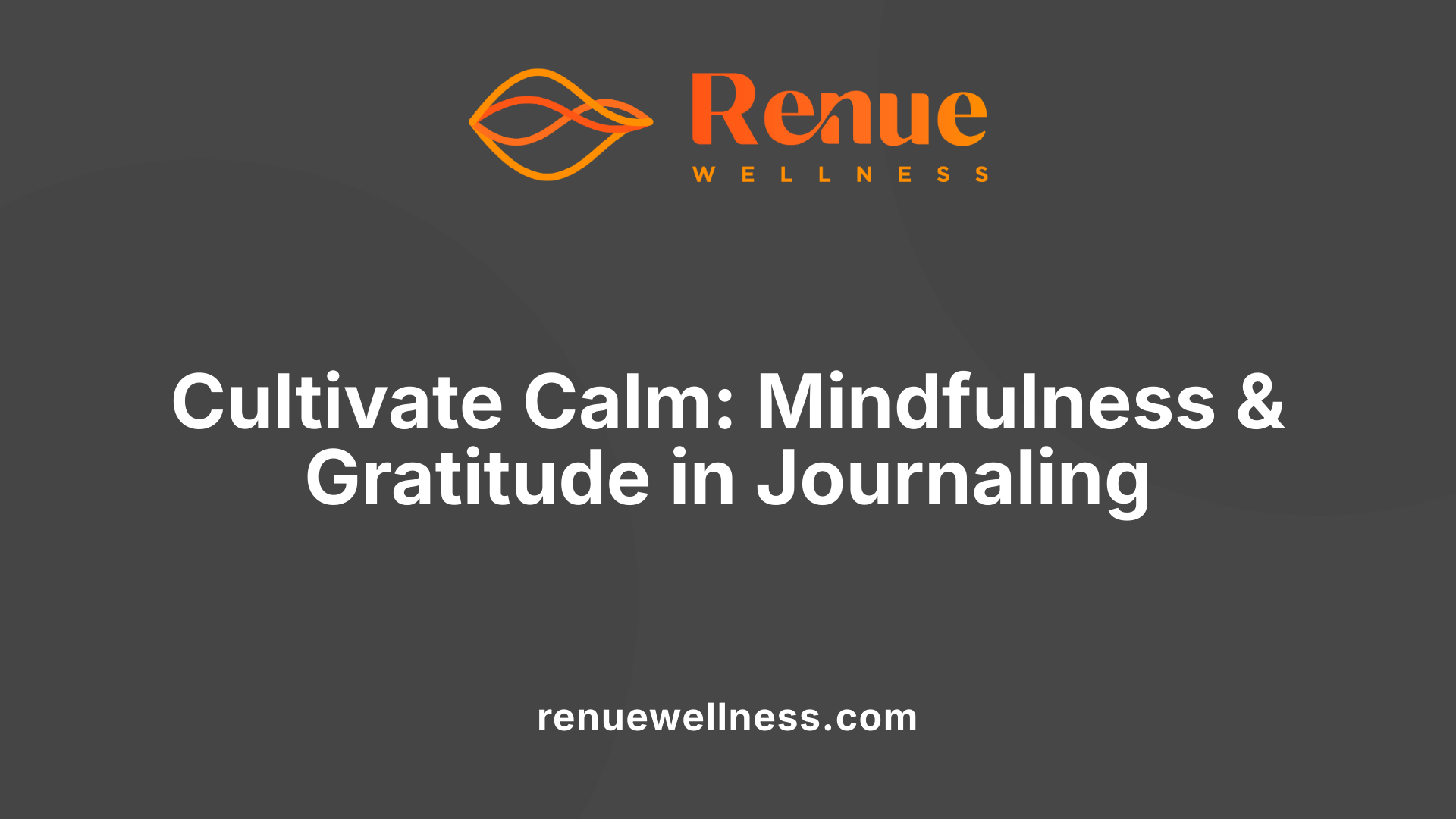How to Journal After Each Infusion: Templates & Prompts


August 7, 2025
Harnessing Journaling to Maximize Infusion Therapy Benefits
Journaling after each infusion, whether for mental health, medical treatments, or emotional processing, is a powerful practice that complements therapy and promotes holistic well-being. This article explores effective methods, prompts, and templates to help you integrate post-infusion journaling into your routine, supporting your journey toward health, mindfulness, and self-discovery.
Understanding the Benefits of Journaling Post-Infusion
Journaling after each ketamine infusion can be a powerful tool for supporting mental health and personal growth. Because ketamine sessions often produce surreal, dream-like experiences that reveal valuable insights, capturing these impressions through writing helps solidify understanding and foster emotional processing.
One of the main advantages of journaling is its ability to enhance emotional regulation. By reflecting on session prompts such as setting intentions or noticing patterns, individuals can better recognize their emotional responses and develop healthier coping mechanisms. This process also significantly reduces stress by providing a safe outlet to express feelings and worries.
Tracking progress in health treatments is another vital benefit. Regular journal entries create a record of insights, mood shifts, and behavioral changes over time, which can be reviewed before subsequent sessions. This ongoing reflection helps assess the effectiveness of treatment and guides future steps.
In addition, journaling cultivates a deeper sense of self-awareness and mindfulness. Techniques like gratitude journals and free writing encourage present-moment focus, fostering a mindful attitude that promotes resilience. Handwriting, in particular, is recommended as it increases neural activity similar to meditation, further reinforcing emotional stability.
To maximize these benefits, it is advised to dedicate about 1-2 pages per session within 24 hours after each infusion. Use targeted prompts—such as noting feelings, insights, or unsaid thoughts—to guide the writing process. Besides original entries, reviewing previous journals aids in recognizing growth and identifying persistent challenges.
Various formats, including bullet lists or digital apps, can be utilized based on personal preference. Additionally, capturing reflections immediately after counseling enhances self-awareness, and journaling about homework tasks ensures accountability.
Scientific evidence supports journaling's role in improving mental health; studies show it can decrease symptoms of depression and anxiety and boost overall wellbeing. For best results, establishing a consistent routine—such as writing for 15 minutes daily—integrates journaling into the healing process and fosters recent insights into emotional resilience and mental clarity.
Creating a Supportive Environment for Post-Infusion Journaling
 Establishing a calming and private space is essential for effective journaling after ketamine infusions. Find a quiet corner or room where you feel safe and undisturbed, ensuring the environment is comfortable with soothing lighting and minimal distractions. This dedicated space encourages you to open up and reflect honestly on your experiences.
Establishing a calming and private space is essential for effective journaling after ketamine infusions. Find a quiet corner or room where you feel safe and undisturbed, ensuring the environment is comfortable with soothing lighting and minimal distractions. This dedicated space encourages you to open up and reflect honestly on your experiences.
Scheduling specific times for journaling helps integrate this practice into your routine. Ideally, set aside 10 to 15 minutes within 24 hours after your infusion to capture fleeting impressions, insights, and emotional responses. Making journaling a consistent part of your post-treatment process reinforces the therapeutic benefits and helps track progress over time.
Choosing a preferred format can make journaling more engaging. Whether it’s long-form writing, bullet points, or using digital apps, select a method that feels natural and sustainable for you. Handwriting in a physical notebook is often recommended, as it activates neural pathways related to mindfulness and deep reflection. Keep your journal, pen, and a comfortable spot nearby to make it easier to stick with the routine.
Starting and maintaining a journaling habit involves keeping it simple and stress-free. Begin with small sessions, using guided prompts like setting intentions or noting emotional patterns, to foster consistency. Over time, as you become more comfortable, you can explore different styles such as gratitude journaling or expressive writing. Remember, the goal is to create a nurturing space that supports emotional processing, enhances insights gained during ketamine therapy, and promotes ongoing mental well-being.
Effective Techniques and Prompts for Post-Infusion Journaling

Using prompts for reflection
Post-infusion journaling benefits greatly from structured prompts that guide individuals to explore their physical sensations, emotional reactions, and thoughts. These prompts encourage capturing fleeting insights and noticing patterns in mood or bodily responses after each session. For example, jotting down how the infusion made you feel physically—such as relaxation or tingling—and emotionally, like joy or anxiety, can deepen your understanding of your responses.
Documenting experiences and insights
Recording experiences immediately following each infusion helps solidify valuable insights gained during the surreal, dream-like state. Prompts that focus on what stood out visually or emotionally during the session support reflection and integration. Writing about challenges faced, breakthroughs achieved, and unresolved questions can foster a richer sense of progress and self-awareness.
Mindfulness and gratitude exercises
Incorporating mindfulness and gratitude into journaling can enhance emotional stability and foster a positive outlook. Prompts such as listing things you are grateful for or describing moments of calm experienced during recovery promote a mindful approach to healing. Techniques like body appreciation, where you acknowledge and thank different parts of your body, or a memory treasure hunt, can deepen emotional regulation.
Tracking physical and emotional changes
Consistently documenting both physical sensations and emotional shifts creates a clear record of progress. Noting improvements or setbacks in mood, energy, or bodily comfort helps identify what strategies support recovery. These entries can include notes on homework completion, new coping mechanisms, or areas needing additional attention.
Templates and prompts for post-infusion journaling to support mental health and self-discovery
| Template/Prompt | Purpose | Details |
|---|---|---|
| Mood and sensation chart | Track physical and emotional state | Rate feelings and sensations on a scale, add reflections |
| Gratitude list | Cultivate positive focus | Write down daily blessings or accomplishments |
| Reflection questions | Deepen self-awareness | What did I learn about myself today? What surprised me? |
| Resilience and growth prompts | Foster emotional growth | How did I handle difficult feelings? What strengths did I notice? |
| Visualization and future goals prompts | Support motivation and hope | Describe your ideal recovery or future self |
Final thoughts
Regular practice using these prompts can optimize the healing process by supporting emotional regulation, reducing stress, and enhancing resilience. Consistent journaling encourages ongoing personal growth and helps create a meaningful connection between each infusion experience and overall recovery trajectory.
The Role of Templates and Structured Formats in Journaling
 Using structured templates and formats can significantly enhance the effectiveness of journaling, especially following medical procedures such as ketamine infusions. These tools offer guidance, foster consistency, and help capture important insights.
Using structured templates and formats can significantly enhance the effectiveness of journaling, especially following medical procedures such as ketamine infusions. These tools offer guidance, foster consistency, and help capture important insights.
Common templates include gratitude logs, mood trackers, and goal-setting sheets. Gratitude journals, for instance, involve noting daily or session-specific things one appreciates, which cultivates positivity and shifts focus toward beneficial aspects of recovery. Mood trackers help identify patterns over time, revealing connections between journaling reflections and emotional states.
Structured reflection exercises involve prompts encouraging deeper exploration of feelings, experiences, and progress. Examples might include questions about the hardest part of the experience, feelings that surfaced, or what was unsaid. These exercises deepen self-awareness and support emotional processing.
Tracking progress through systematic formats allows individuals to observe subtle changes across sessions. For instance, progress charts can chart mood, resilience, or specific insights gained, providing motivation and evidence of growth.
Effective journaling post-infusion benefits from consistent use of these templates. A recommended approach is to dedicate a few pages—about 1-2 per session—immediately after, and to review previous entries before future sessions. This review offers a clear sense of progression, helps refine focus, and promotes continual personal development.
Incorporating these structured tools not only organizes thoughts but also reinforces the therapeutic process, fostering resilience and emotional well-being over time. By aligning templates with personal goals and using prompts tailored to individual experiences, journalers can maximize benefits from each session and build a meaningful narrative of their healing journey.
Incorporating Mindfulness and Gratitude in Your Journaling Practice
 To fully experience the benefits of journaling for emotional processing and mindfulness, incorporating specific exercises such as mindfulness, gratitude, check-ins, and positive affirmations can be highly effective.
To fully experience the benefits of journaling for emotional processing and mindfulness, incorporating specific exercises such as mindfulness, gratitude, check-ins, and positive affirmations can be highly effective.
Mindfulness exercises in journaling involve paying close attention to your present feelings, sensations, and thoughts. This can be done through prompts that ask you to describe your current state without judgment or to focus on sensory details. Techniques like doodling, coloring, or mindful check-ins help you stay grounded and foster a calm mind.
Gratitude journaling encourages you to regularly note things you appreciate in life. By writing three to five gratitude entries daily or weekly, you cultivate a positive outlook, reduce stress, and enhance emotional resilience. This simple practice shifts focus away from worries and promotes a sense of contentment.
Check-in exercises and positive affirmations involve assessing your mood, thoughts, and overall mental space. Prompts such as "How am I feeling today and why?" or "What positive affirmation can I repeat today?" help you stay aware of your internal state and foster self-compassion. Writing these affirmations reinforces positive beliefs and supports mental health.
Starting and maintaining a journaling habit can seem daunting at first. Begin with just a few minutes each day in a comfortable, quiet space. Use prompts or free writing to honestly explore your thoughts and feelings. Consistency—whether daily or several times a week—builds a routine, making the activity part of your self-care practices.
By integrating gratitude, mindfulness, and check-in exercises into your journaling, you create a powerful tool for emotional clarity. Over time, this practice can improve mood, increase self-awareness, and promote overall well-being.
For more techniques and detailed guidance, searching "mindfulness and gratitude journaling techniques" can provide additional resources and templates to tailor your journaling journey.
Tracking Progress and Reflection Over Time

How can journaling support therapy, health treatments, or emotional reflection?
Journaling, especially after each ketamine infusion, plays a vital role in supporting mental health and emotional growth. It provides a dedicated space to record fleeting impressions, insights, and physical or emotional responses right after treatment.
Participants often set specific prompts for each session, such as outlining intentions or noting patterns that emerge during their experiences. This practice helps individuals recognize progress, identify recurring themes, and understand emotional triggers.
Reviewing previous entries before subsequent sessions allows for tracking changes over time and observing how certain insights or lifestyle adjustments influence overall well-being. It also enhances self-awareness, fostering a deeper understanding of personal growth.
The practice of journaling supports broader therapy and health treatments by reinforcing insights gained during therapy sessions or medication adjustments. It can also serve as a calming activity that reduces stress, increases emotional regulation, and cultivates resilience.
Furthermore, writing about surreal, dream-like ketamine experiences often uncovers valuable subconscious messages. Journaling helps organize these insights, making them more accessible for reflection and integration.
Tools such as guided templates or structured prompts—covering feelings, hardest parts, or unsaid thoughts—aid individuals in capturing comprehensive reflections. Handwriting these notes, rather than typing, encourages neural activity similar to meditation, deepening emotional processing.
Participants are encouraged to dedicate about 1-2 pages per session and complete their entries within 24 hours. Consistent review of previous entries is recommended to monitor progress and adjust treatment or self-care strategies accordingly.
In summary, journaling after each infusion or therapy session enhances emotional awareness, facilitates insight integration, and promotes ongoing personal development. As an accessible and flexible practice, it empowers individuals to take an active role in their health journey and mental well-being.
Integrating Journaling with Other Self-Care Methods
Combining journaling with relaxation or exercise can deepen its benefits, providing a holistic approach to self-care. For example, pairing journaling with mindful breathing exercises or gentle physical activity helps create a calming environment conducive to honest reflection.
Incorporating journaling into a broader self-care routine involves intentionally dedicating time to reflect on feelings, progress, and goals. This might include setting a consistent schedule, such as journaling before bed or after a workout, to reinforce emotional awareness and resilience.
Using expressive writing and creative activities alongside traditional journaling can diversify self-care practices. Doodling, poetry, or visual arts allow for emotional expression that words alone might not capture, enriching the healing process.
Techniques and Tips for Effective Journaling After Medical Procedures or Infusions
To enhance the benefits of journaling post-treatment, employ structured approaches like prompts and sentence stems. These tools provide guidance, helping focus thoughts and encourage meaningful insights.
Establishing a routine is crucial. Dedicate a specific time and private space for writing, whether it's daily or weekly, creating a habit that supports ongoing emotional processing.
Vary your methods to suit your preferences. Handwriting can boost neural activity, while voice recordings or art can make journaling more accessible and engaging.
Use prompts focused on your medical experience—such as exploring feelings, triggers, or personal growth—to facilitate deeper understanding.
Supportive techniques like gratitude lists or tracking your progress toward recovery enhance positivity and resilience over time. Combining these strategies can turn journaling into an integral part of your healing journey, reinforcing emotional well-being beyond the immediate medical procedure.
Assessing the Impact and Benefits of Your Journaling Practice
Regular journaling after ketamine infusions offers valuable insights into emotional and physical experiences, helping to track progress and foster personal growth. To evaluate how helpful your journaling has been, it’s useful to reflect on whether it encourages clarity, emotional regulation, and self-awareness. Participants often rate their perceived benefits on a scale from 1 to 10, with many finding significant relief from anxiety, increased insight, and improved mood through consistent practice.
Tracking emotional and physical improvements over time can be achieved by reviewing previous entries. Noticing patterns, mood shifts, and responses to therapy helps assess shifts in mental health and resilience. This ongoing review supports setting realistic goals and identifying areas for further focus.
To keep your journaling purposeful, consider establishing goals like fostering gratitude, processing difficult feelings, or tracking therapy progress. Next steps may involve adapting prompts, trying new formats such as digital apps or doodling, or increasing journaling frequency to deepen benefits. Reflecting on your journey with dedicated journaling acts as a mirror to your personal development, empowering you to continue growth and emotional well-being.
Cultivating a Routine for Lasting Benefits
Integrating thoughtful, regular journaling after each infusion or medical treatment can profoundly enhance mental health, emotional resilience, and overall well-being. By leveraging structured templates, prompts, and mindfulness techniques, individuals can deepen self-awareness, track personal growth, and foster a positive, proactive approach to healing. Committing to a consistent journaling practice — even amid the fluctuations of health journeys — ensures that the insights gained translate into sustained progress and a more mindful, fulfilled life.
References
- 35 Journal Prompts to Supercharge Your Ketamine Therapy ...
- [PDF] Journaling After Your Therapy or Counseling Sessions
- Journaling for Mindfulness: 44 Prompts, Examples & Exercises
- Manifestation Journal: Tips, Templates & Prompts - Mindvalley Blog
- Journaling Prompts For Mental Health - Mindful Health Solutions
- How to journal for Mental Health - Wellnest
- 26 daily journal prompts: Spark your self-reflection journey - Rosebud
- How I Use a Night Journal to Put My Thoughts to Bed
- Journaling Prompts For Mental Health - Mindful Health Solutions
- 30 Best Journaling Prompts for Improving Mental Health
Recent Posts
Conditions Treated
AnxietyDepressionOCDPTSDPostpartum DepressionPain ManagementSubstance AbuseSuicidal IdeationOur Location


